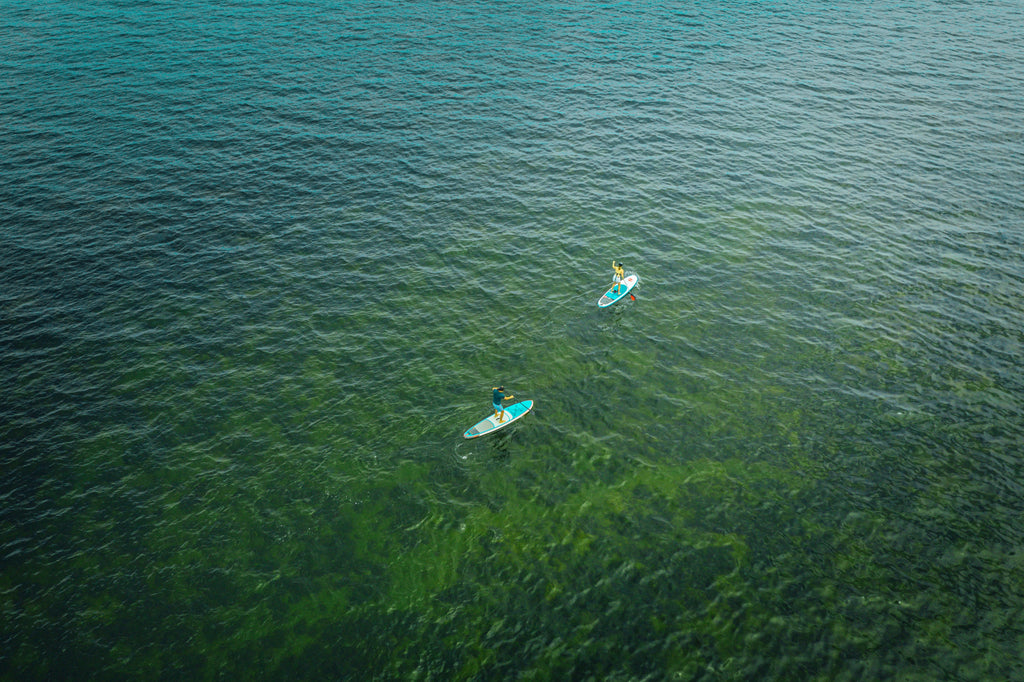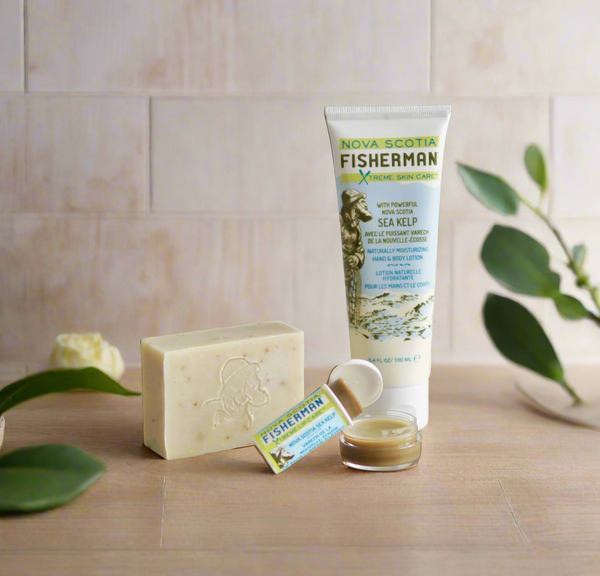Your Cart is Empty

Switching from Liquid to Bar Soap - Skip The Bottle
August 22, 2019 5 min read
The Simple Swap.
At this point, we’re all aware that improperly-disposed, and dense non-recyclable plastic is filling our oceans, our landfills, and our lives.
This year, we’ve been making steps to help reduce our use of non-recyclable plastics & energy both in our manufacturing processes, as well as in our packaging.
However, our efforts have also been in educating conscious consumers on more sustainable alternatives, and what harm some commercial products can cause their skin, and to the environment. The easiest swap most of us can make, is embracing good old-fashioned bar soap.
So, why is bar soap a more environmentally conscious option…

1. One bar to do it all
At Nova Scotia Fisherman, our staff all keep one bar in the shower, one bar on the bathroom counter, one by the sink in the kitchen, and a few small bars for travel & guests. In most all cases, they replace synthetic liquid soap in plastic bottles, that we would use for these purposes. They even lend a hand scrubbing stains from a shirt, lathering up a dish brush when out of dish soap, or lathering up in a washcloth to wipe down the counter in a pinch.
Our sea kelp soaps are safe for all skin types, and are made using only natural ingredients and a cold-process method - This means they last long, don’t contain any additives or chemicals, and are safe for hands, face, body, and hair (both humans and animals).

2. Packaging - Skip the bottle
Switching to bar soaps is possibly the easiest way you can positively impact your footprint by reducing unnecessary chemicals, additives, and plastics.
If you do a search, you’ll be able to find soaps that have zero packaging, or come in paper packaging that is recycle friendly. However, watch out for paper packaging that is plastic-lined, or waxy, and therefore not recyclable! (quite common).
This summer, we’re (Nova Scotia Fisherman) moving to 100% paper packages for our soap bars, that are completely recyclable / compostable. This allows us to protect the premium bars as they head to stores or your home, while helping to reduce the environmental footprint.
Replacing plastic from liquid hand soaps, facial cleansers, shampoos, and body washes for an entire year adds up fast. Switching to bar soaps is an easy way to get started, and set a habit of being more conscious day-to-day.

3. It lasts - and has a long expiration date
Our bar soaps are made using the traditional, cold process method, where no heat is applied to the oil base, or during the curing process which helps maintain nutritional and nourishing power for your skin.
Once the soap has cured, it doesn’t really go bad. We have to give each product a shelf life, however due to any lack of chemical compounds that break down and erode over time, each bar will remain fresh and dense for a long period of time.
As the bar loses moisture content, the lather it produces becomes thicker. We cure each bar 6-8 weeks prior to it hitting shelves or arriving at your doorstep. This helps speed up the curing process and you receive a bar that will last, create a luxurious lather, and leaves little footprint on the planet.

4. It’s friendly to the earth and to the drain
Bar soaps, on average, require about one-fifth the energy to manufacture liquid soaps and detergents.
Commercial liquid body washes are made with synthetic detergents, fragrances, and preservatives that provide no benefits to our bodies and are harmful to the environment. Many of these compounds add to the shelf life of the product as preservatives, artificial scents & colours, as well as lathering agents.

In 2015, there was an interesting study conducted by Zurich’s Institute of Environmental Engineering. Scientists assessed three categories of cleaners: laundry detergent, body soap, and surface cleaners.
The goal was a first-ever life cycle impact assessment (LCIA) of these types of products. An LCIA takes into account the environmental cost across the product’s lifetime:
Manufacturing
Transport & Storage
Use
Disposal
The scientists used industry data, customer behavior studies, and information from the ecoinvent database on product lifecycle information. In some cases they had to contact the manufacturers themselves.
The scientists found that based on consumer studies, in a one-time, 30-second hand wash, people used .35g of bar soap, and 2.3g of liquid soap. It takes more than six times the amount of liquid soap to accomplish the same task. It’s like the difference between driving to work in a Chevy Volt or a Ford Expedition. You get to the same place, but you use a lot more gas to do it.
If 6x more of a product is needed to do the same task, then that’s 6x the raw materials to manufacture it, 6x the space in the truck needed to transport it, 6x the shelf space in the heated store to present it to consumers.

The scientists found that liquid soap has 10x the carbon footprint of bar soap. Two major culprits here: The chemicals that are used to manufacture liquid soap, and the fact that the soap is packaged in wasteful plastic.
In storage and transport, liquid soap isn’t packaged very efficiently—while bar soap is packaged in stackable bars. All those little bits of wasted space in the boxes and shelves adds up.

Finally, the chemicals used in liquid soap require far more wastewater treatment than those used in bar soap. And the plastic containers liquid soap comes in are often incinerated, if not disposed of properly, or if the plastic compound isn’t easily recycled.

5. It cleanses and moisturizes at the SAME TIME
Just as a body wash, bar soaps made from nourishing natural oils are moisturizing your skin, repairing, and strengthening, while at the same time cleansing and removing dirt. Commercial liquid body washes are manufactured to run from your skin after cleansing, while bar soaps allow the natural oils to replenish the skin’s moisture levels while you’re cleaning.
Skincare expert Jennifer Rock, founder of the Skin Nerd online consultancy - “People spend a lot of time and money researching cleansers and moisturizers for the face, but then jump into the shower and use anything. As a result, our body’s skin is woefully neglected”. She says one of the most common pictures they’re sent on Instagram is of acne on body parts. “It’s such a common problem.”
Her first tip is to think about your body as much as you do your face, both in terms of routine and product. Second, her most salient tip is to read the label carefully. "Look for aloe, coconut, olive, castor and glycerine. You don’t want anything too heavily scented or colourful: synthetic dyes are irritating."
“If you consistently need to moisturize after you have washed, you are probably not using the right soap: Invest in a better one, and you can probably cut back on the everyday cream for full body.”
So, now that you know a bit about the differences, we dare you to give it a try and see if you miss your liquid soaps! Save 15% on any sea kelp soap bar + soap dock using code “SKIPTHEBOTTLE” at checkout.
PRO TIP for converting friends & family - Choose a slatted soap dish like our Soap Dock.. Water pools in soap dishes that don’t offer it a place to drain, which decreases the lifespan of the bar and makes things a bit slimy!

Shop Sea Kelp Soaps
References:
https://aclca.org/
https://www.ecoinvent.org/
https://ifu.ethz.ch/
https://insteading.com/blog/bar-soap-better-liquid-soap/
Leave a comment
Comments will be approved before showing up.
Subscribe
Sign up to get the latest on sales, new releases and more …

Receive 15% OFF Your First Order
Plus First Updates on Sales, New Products & FREE SHIPPING on Orders $100+ (Canada & USA)
